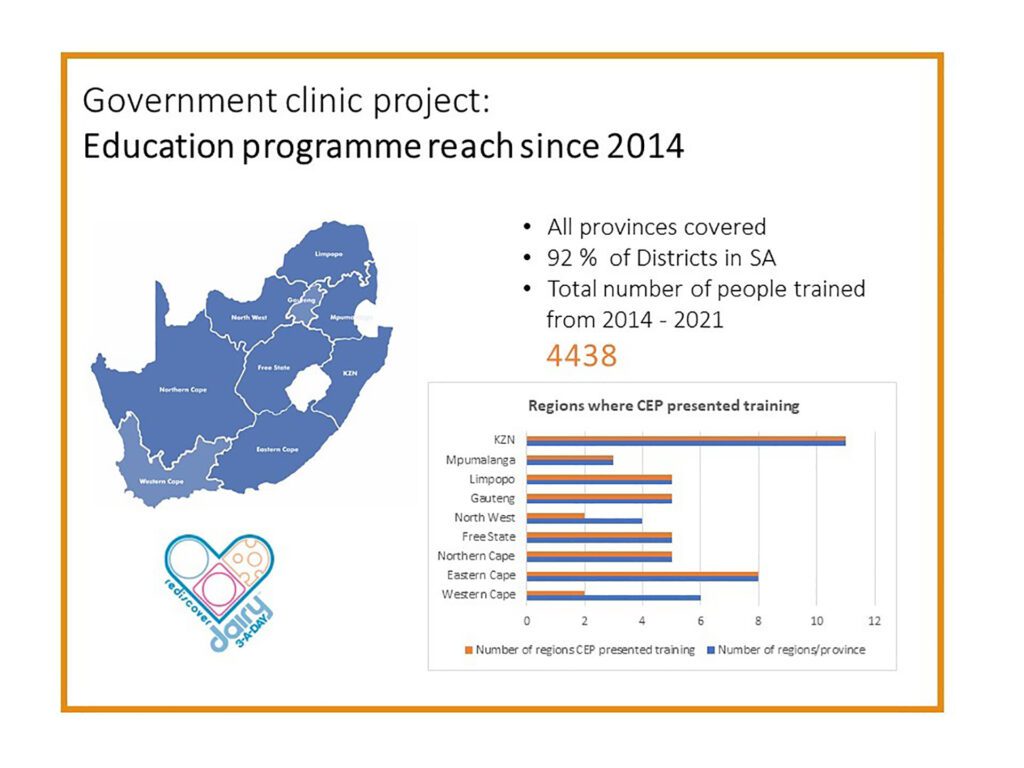Share this page


Alignment with SDGs
AUTHOR
Christine Leighton, Maretha Vermaak – Milk South Africa, Pretoria, South Africa
Abstract
The Consumer Education Project of Milk SA (CEP of Milk SA) introduced a training programme to address malnutrition, poverty and hunger through quality education to communities in South Africa that are nutritionally at risk.
South Africa’s population of 58 million people is culturally diverse. The country consists of nine provinces and there are 11 official languages. About a third of South Africans live in rural areas. Poverty affects more than half of the population and one in five households is reported to run out of money for food during a month. For many South Africans, access to affordable, nutritious foods is limited.
The high rate of unemployment and associated poverty in South Africa, although less than in many other countries, have resulted in many nutritional challenges among its population. These include overweight and obesity; deficiencies in vitamin A, iron, calcium and potassium; diets without sufficient energy and nutrient density; hypertension and diabetes.
This education programme aims to reach nutritionally vulnerable South Africans from the low socioeconomic sector of the population. Its focus is to communicate the value of milk and other dairy products in the daily diet, as included in the South African FBDGs, to improve the well-being of the population.
Since 2014, the CEP of Milk SA has presented this education programme in each of the nine provinces in South Africa, with 92% of rural regions and townships reached. A total of 4500 health promoters have been trained so far.
Introduction
The CEP of Milk SA, a project of Milk South Africa, aims to communicate the health and nutritional benefits of dairy to consumers and health professionals.
The CEP of Milk SA runs various communication initiatives, each aimed at a defined target market in a socioeconomically and culturally diverse population. One of these initiatives specifically aims to reach nutritionally vulnerable South Africans from the low socioeconomic sector of the population.
This education programme focuses on communicating the value of milk and dairy in the daily diet, as included in the South African food-based dietary guidelines (FBDGs), to improve the well-being of this specific consumer group.
Materials and methods
Health promoters and community workers that are employed by the Department of Health and work in collaboration with government clinics, are trained on the value of adding dairy to a diet that typically lacks in calcium, potassium and Vitamin A.
This education programme communicates the health and nutritional benefits of milk and other dairy products through well-structured education actions that were developed in accordance with the South African FBDGs. The FBDGs include local and affordable foods that support healthy eating.
An important element of the education programme is regular one-day training events in rural regions across the various provinces. The process involves training health promoters and community health workers, who, in turn, educate their direct local communities in their region.
Each health worker who attends the one-day training event, receives a dairy-focused training tool, posters and pamphlets to support their community-based nutrition education. The pamphlets are used as handouts to the community and are available in nine of the eleven official languages. An educational video titled ‘Why dairy is good for you (Tumi)’, is available in five languages or dialects. All training material and hand-outs were developed by the Consumer Education Project of Milk SA and are distributed free of charge. and can be downloaded from the website https://www.rediscoverdairy.co.za/community-work/clinic-project/.
Dairy foods are naturally nutrient-dense, regularly consumed by billions of people around the world, affordable and contribute to livelihoods. This education programme will provide a lasting impact on the overall health status of the South Africans population at large.
Christine Leighton, Maretha Vermaak Tweet
Results
In 2017, the outcomes of the training events were measured in order to evaluate its effectiveness. The purpose of the research was to:
measure the recall rate
determine the value or usefulness of the training
get feedback about the use of the training material
establish the main learning points
understand the use and benefits of the training material (posters, pamphlets).
The research showed that the training events are highly functional and based on these results, the training initiative is ongoing in rural regions and townships.


Discussion
The value of this education initiative lies in the commitment to communicate the nutrient richness of dairy to consumers who are nutritionally at risk, thereby highlighting how beneficial it is to ‘just add dairy’ to the diet that is typically nutritionally compromised. This training programme, presented across South Africa, contributes to build a healthier population overall. The main beneficiary is the Department of Health, whose employees are upskilled at no cost to the public health system.
Conclusion
The FBDG afforded the CEP of Milk SA the opportunity to communicate the importance of dairy in the diet of all South Africans and forms the basis of the content communicated in this education programme. Such a programme, that is ongoing, will have lasting impact on the overall health status of the population at large. An opportunity exists to expand the training to school nurses in specific selected rural and township communities1.(Townships were usually built on the periphery of towns and cities).
References
South Africa Demographic and Health Survey 2016. Key Indicators Report. National Department of Health. Pretoria, South Africa. Available from https://dhsprogram.com/pubs/pdf/FR337/FR337.pdf
Shisana O, Labadarios D, Rehle T, et al. 2013. The South African National Health and Nutrition Examination Survey SANHANES-1. Human Sciences Research Council & Medical Research Council. HSRC Press: Cape Town.
Vorster HH, Badham JB, Venter CS. An introduction to the revised food-based dietary guidelines for South Africa. S Afr J Clin Nutr 2013;26(3):S1-S164.
Vorster HH, Wenhold FAM, Wright HH, Wentzel-Viljoen E, Venter CS, Vermaak M. Food-based dietary guidelines for South Africa: Have milk, maas or yoghurt every day. S Afr J Clin Nutr 2013;26(3)(Supplement):S57-S65.
Food and Agricultural Organization. Food-based dietary guidelines of South Africa. Available from: http://www.fao.org/nutrition/education/food-based-dietary-guidelines/regions/countries/south-africa/en/ (accessed on January 2021).






